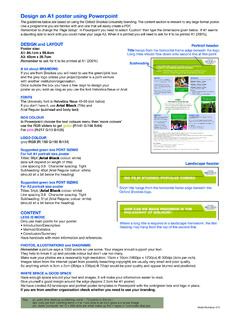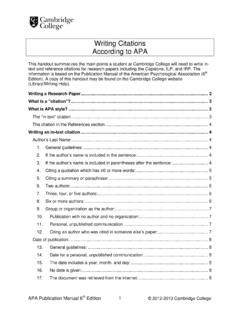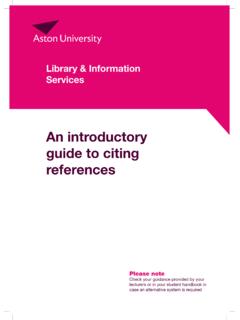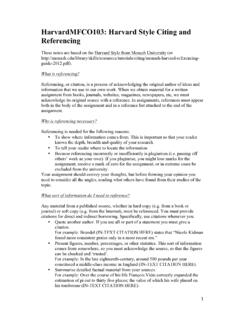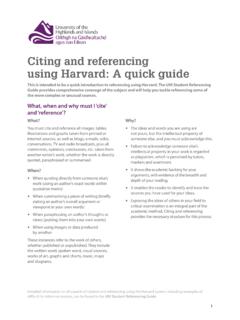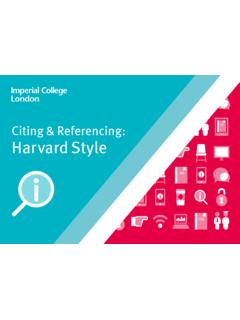Transcription of Citing your references using the Harvard (Author-Date) system
1 LIBRARY Citing your references using the Harvard (Author-Date) system Is this the correct guide for you? Before using this guide, please check whether your Department, School or Faculty specifies the use of a particular referencing style and, if so, if it provides its own guidelines to that style. This guide is in line with Cite them right online - - and the printed book equivalent: Pears, R. and Shields, G. (2022) Cite them right: the essential referencing guide. 12th edn. London: Bloomsbury Academic. Call number PEA Why is it important to cite references ? to enable other people to identify and trace your sources quickly and easily to support facts and claims you have made in your text It is accepted practice in the academic world to acknowledge the words, ideas or work of others and not simply to use them as if they were your own.
2 Failure to do this could be regarded as plagiarism see 1. In-text citations The in-text citation is placed at the exact point in your document where you refer to someone else s work, whether it is a book, journal, online document, website or any other source. The following guidelines apply to all types of sources, including online documents & websites. The in-text citation consists of author (or editor) and publication year, in brackets Agriculture still employs half a million people in rural Britain (Shucksmith, 2000). An author can be an organisation, corporate body or Government Department (initials or abbreviations can be used if well known) Research Guide 2 There are 2 parts to a referencing system : (1) an in-text citation (2) an entry in the reference list/bibliography at the end of the assignment/work 2 (English Heritage, 2020) (NHS, 2020) If there are 2 or 3 authors, both, or all 3, names should be given (Lines, Pritchard and Walker, 2017) If there are 4 or more authors, cite the first author, followed by et al.
3 (in italics) (Morgan et al., 2021) To refer to 2 or more publications at the same time, list in date order, separated by a semicolon (Taylor, 2013; Piper, 2015) For several documents by the same author published in the same year, use (a, b, c) (Watson, 2020a) If the author s name occurs naturally in the sentence, only the year of publication is given In his groundbreaking study, Jones (2014) .. If the date cannot be identified, use the phrase no date (Labour Party, no date) If there is no author, including web pages, Acts of Parliament & law cases, use a brief title instead (Burden of anonymity, 1948) (title in italics) (Fire Safety Act 2021) (no comma is needed if you re referring to an Act) ( YL v.)
4 Birmingham City Council , 2007) (single quotation marks, not italics) For web pages with no author or title, use the URL and date (If a web page has no author or title, you might question whether or not it is suitable for academic work.) ( , 2018) Secondary referencing This is a document which you have not seen but which is quoted or mentioned in a source you do have. Link the 2 sources with the term cited in or quoted in : (Turner, 2013, cited in Walker, 2021, p. 53). Turner s analysis of development trends (2013, cited in Walker, 2021, p. 53). You can only include the source you have actually read in your reference list, so, in this example, you would only include Walker.
5 (It is good practice to try to read the original source (Turner) if possible.) In-text citations and page numbers: These should be included when there is a need to be more specific, referring to specific information or data, or when making a direct quotation. Use p. (for a single page) or pp. (for more than one page). If page numbers are not given ( for some ebooks), use the information that is available, such as %, chapter/paragraph. (Thompson, 2021, p. 100) or (Thompson, 2021, 58%) 3 2. Reference list/bibliography At the end of your assignment/work you need to provide a complete list of all sources used. Please note that some Departments, Schools or Faculties may expect 2 lists (1) a reference list of all sources cited in your text and (2) a general bibliography of sources used but not specifically cited as in-text citations.
6 The entries in the list(s) are arranged in one alphabetical sequence by author s name, title if there is no author, URL if no author or title whatever has been used in the in-text citation, so that your reader can go easily from an in-text citation to the correct point in your list. What details should be in the reference? All references , including those for online resources, must contain author, year of publication and title (if known) in that order. Further details are also required, varying according to type of source (see below). Printed books or reports AND Ebooks which look the same as a printed book, with publication details and pagination 1 Author/Editor: Surname/family name first, followed by initials Include all authors, except where there are 4 or more, when you can give the first name followed by et al.
7 (in italics) For editors, use (ed.) or (eds) If an abbreviation has been used for a corporate author in the in-text citation, use the abbreviation in the reference list too ( NHS) 2 Year of publication: Give the year of publication in round brackets, or (no date) 3 Title: Include title as given on the title page of a book Handling Quotations in the text: Short quotations may be run into the text, using single or double quotation marks (be consistent): As Owens stated (2018, p. 97), the value Longer quotations should be a separate, indented, paragraph no need for quotation marks: Simone de Beauvoir examined her own past and wrote rather gloomily: The past is not a peaceful landscape lying there behind me, a country in which I can stroll wherever I please, and will gradually show me all its secret hills and dales.
8 As I was moving forward, so it was crumbling (Simone de Beauvoir, 1972, p. 365). Top tip If your source has 4 or more authors you can either write them all out in the reference or use the first author followed by et al. (in italics). Some courses or publishers may want you to list all authors. If you re not sure whether you need to list them, check with your module leader. 4 Include any sub-title, separating it from the title by a colon Capitalise the first letter of the first word and any proper nouns Use italics 4 Edition: Only include if not the first edition. Edition is abbreviated to edn . 5 Place of publication and publisher: Use a colon to separate these elements.
9 If there is more than one place of publication, include only the most local. 6 Series: Include if relevant, after the publisher. Online reports OR Ebooks for which publication details and page numbers are not available 1 Author/editor 2 Year of publication (in round brackets) 3 Title (in italics) 4/5 Available at: URL (Accessed: date) Chapter in book 1 Author of chapter 2 Year of publication 3 Title of chapter (in single quotation marks) 4 in and then author, title of complete book (in italics), place of publication, publisher, page nos. Journal articles, print and electronic 1 Author (if there are 4 or more authors, you may use the first author et al.)
10 , or all authors) 2 Year of publication 3 Title of article (in single quotation marks) 4 Title of journal (in italics). Capitalise the first letter of each word in title, except for words such as and , the , of Example of printed book, or ebook which looks like a printed book, or report: Shone, A. and Parry, B. (2013) Successful event management: a practical handbook. 4th edn. Andover: Cengage Learning. Example of organisation/corporate body/Government Department as author: Department of Health (2012) Manual of nutrition. 12th edn. London: TSO. Example of book with no author: Whitaker s 2019 (2018) London: Bloomsbury Yearbooks.

